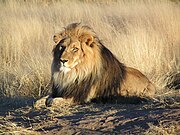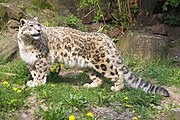The Pantherinae is a subfamily of the Felidae; it was named and first described by Reginald Innes Pocock in 1917 as only including the Panthera species.[2] The Pantherinae genetically diverged from a common ancestor between 9.32 to 4.47 million years ago and 10.67 to 3.76 million years ago.[3][4]
| Pantherinae[1] Temporal range: | |
|---|---|
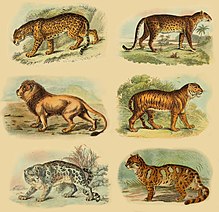 | |
| Pantherinae subfamily members (from left): jaguar, leopard, lion, tiger, snow leopard and clouded leopard | |
| Scientific classification | |
| Domain: | Eukaryota |
| Kingdom: | Animalia |
| Phylum: | Chordata |
| Class: | Mammalia |
| Order: | Carnivora |
| Suborder: | Feliformia |
| Family: | Felidae |
| Subfamily: | Pantherinae Pocock, 1917 |
| Genera | |
| |
Characteristics
Pantherinae species are characterised by an imperfectly ossified hyoid bone with elastic tendons that enable their larynx to be mobile.[2] They have a flat rhinarium that only barely reaches the dorsal side of the nose. The area between the nostrils is narrow, and not extended sidewards as in the Felinae.[5]
The Panthera species have a single, rounded, vocal fold with a thick mucosal lining, a large vocalis muscle, and a large cricothyroid muscle with long and narrow membranes. A vocal fold that is longer than 19 mm (0.75 in) enables all but the snow leopard among them to roar, as it has shorter vocal folds of 9 mm (0.35 in) that provide a lower resistance to airflow; this distinction was one reason it was proposed to be retained in the genus Uncia.[6][7]
Evolution
The Felidae originated in Central Asia in the Late Miocene; the subfamily Pantherinae diverged from the Felidae between 14.45 to 8.38 million years ago and 16.35 to 7.91 million years ago.[3][4] Several fossil Panthera species were described:
- Panthera blytheae is the oldest known species that possibly lived about 5.95 to 4.1 million years ago.[8]
- Panthera palaeosinensis lived in the early Pleistocene around two to three million years ago in northern East Asia.[9]
- Panthera zdanskyi is dated to 2.55 to 2.16 million years ago.[9]
- Panthera gombaszoegensis lived from about 2 to 0.35 million years ago in Europe.[10]
- Panthera youngi lived in the Pleistocene about 0.69 to 0.42 million years ago in China.[11]
- Panthera spelaea lived in Europe after the third Cromerian interglacial stage from about 450,000 to 14,000 years ago.[12]
- Panthera atrox lived in North America during the Pleistocene and early Holocene about 340,000 to 11,000 years ago.[13]
- Panthera shawi was a lion-like cat in South Africa that possibly lived in the early Pleistocene.[14]
- Panthera balamoides lived in the Yucatan Peninsula in Mexico, during the Pleistocene.[15]
An additional fossil genus Leontoceryx was described in 1938.[16]
There is evidence of distinct markers for the mitochondrial genome for Felidae.[17][18]
Results of a DNA-based study indicate that the tiger (Panthera tigris) branched off first, followed by the jaguar (P. onca), the lion (P. leo), then the leopard (P. pardus) and snow leopard (P. uncia).[19]
Felis pamiri, formerly referred to as Metailurus, is now considered a probable relative of extant Pantherinae and was moved to the genus Miopanthera.[20]
Taxonomy
Pocock originally defined the Pantherinae as comprising the genera Panthera and Uncia.[2] Today, Uncia has been subsumed into Panthera, and the genus Neofelis is also included.[21]
Living genera
The following table shows the extant taxa within the Pantherinae, grouped according to the traditional phenotypical classification.[21]
| Common name | Scientific name and subspecies | Range | Size and ecology | IUCN status and estimated population |
|---|---|---|---|---|
| Clouded leopard | N. nebulosa (Griffith, 1821) | Central Nepal to continental Southeast Asia and southern China | Size: head to body 68.6–108 cm (27.0–42.5 in) with 61–91 cm (24–36 in) long tail[22] Habitat: Forest and shrubland[23] Diet: Medium-sized and small mammals on the ground and in trees, as well as birds[23] | VU
|
| Sunda clouded leopard | N. diardi Cuvier, 1823 Two subspecies
| Parts of Sumatra and Borneo | Size: 69–108 cm (27–43 in) long, 61–91 cm (24–36 in) tail[24] Habitat: Forest[25] Diet: Medium-sized and small mammals[25] | VU
|
| Common name | Scientific name and subspecies | Range | Size and ecology | IUCN status and estimated population |
|---|---|---|---|---|
| Jaguar | P. onca (Linnaeus, 1758) | Large swathes of South and Latin America, and Arizona in the United States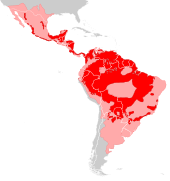 | Size: 110–170 cm (43–67 in) long, 44–80 cm (17–31 in) tail[26] Habitat: Forest, shrubland, inland wetlands, savanna, and grassland[27] Diet: Variety of mammals, reptiles and birds, preferring ungulates[27] | NT
|
| Leopard | P. pardus (Linnaeus, 1758) Eight subspecies
| Much of Sub-Saharan Africa, the Middle East, the Indian subcontinent, the Caucasus in Europe, Southeast Asia, and Siberia | Size: 91–191 cm (36–75 in) long, 51–101 cm (20–40 in) tail[28] Habitat: Forest, desert, rocky areas, grassland, savanna, and shrubland[29] Diet: Ungulates, as well as other mammals, insects, reptiles, and birds[29] | VU
|
| Lion | P. leo (Linnaeus, 1758) Two subspecies | Sub-Saharan Africa and India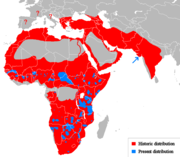 | Size: 137–250 cm (54–98 in) long, 60–100 cm (24–39 in) tail[30] Habitat: Forest, grassland, shrubland, savanna, and desert[31] Diet: Ungulates such as antelopes, zebra, and wildebeest, as well as other small to large mammals[31] | VU
|
| Snow leopard | P. uncia (Schreber, 1775) | Himalayas reaching north to Mongolia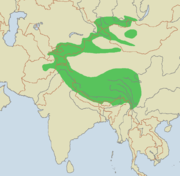 | Size: 90–120 cm (35–47 in) long, 80–100 cm (31–39 in) tail[32] Habitat: Shrubland, rocky areas, forest, and grassland[33] Diet: Caprids such as sheep and goats, as well as small mammals and birds[33] | VU
|
| Tiger | P. tigris (Linnaeus, 1758) Two subspecies
| Scattered sections of Southeast Asia, Indian subcontinent, and Siberia | Size: 150–230 cm (59–91 in) long, 90–110 cm (35–43 in) tail[34] Habitat: Shrubland, forest, and grassland[35] Diet: Deer and wild pigs, as well as a wide variety of other animals[35] | EN
|
See also
References
External links
- Choi, C. Q. (2011). "World's Oldest Tiger Species Discovered". Live Science. Retrieved 2019-06-30.





